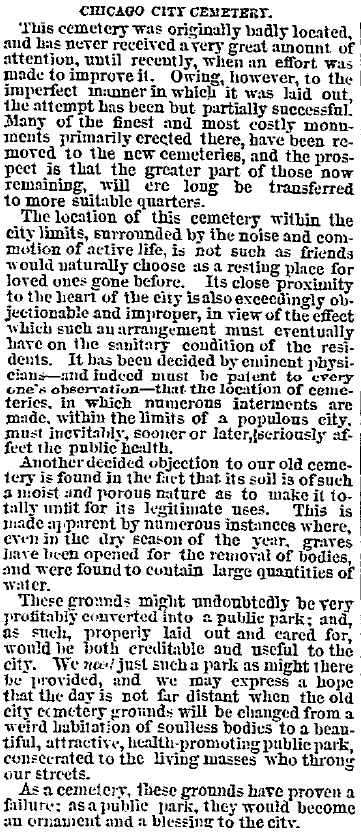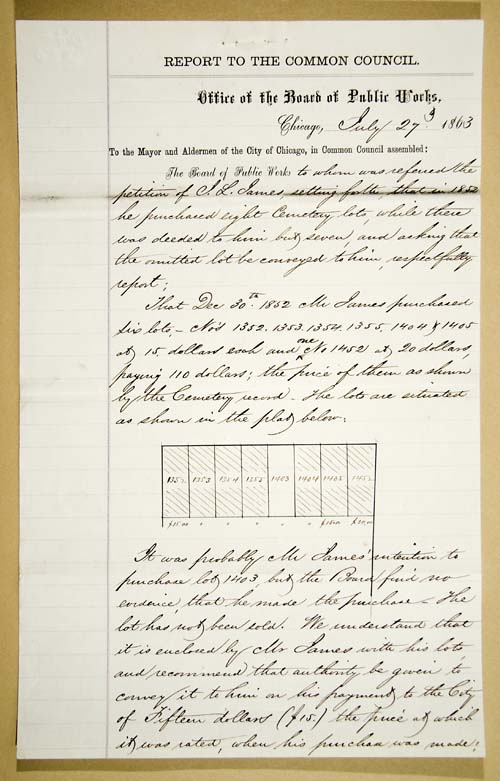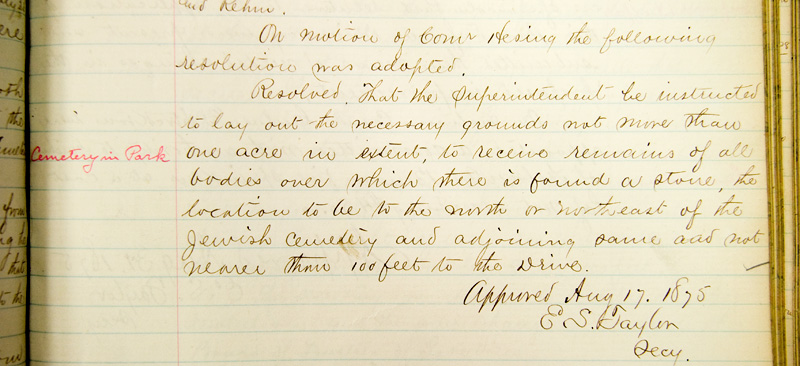|
On May 1, 1859, the last burial lots were sold in the City Cemetery. Although this meant the cemetery would not be further developed, it did not stop lot owners from interring within their family-owned plots. The order to stop sales also did not affect the burials in the potter's field. Interments continued for six more years. Dr. John H. Rauch wrote in 1866, that from January 1860 until March 1866, a total of 15,212 bodies, including those of nearly 4000 Confederate prisoners, were buried in the City Cemetery and its potter's field. |
Chicago, January 7, 1860 Gentlemen In compliance with your request the undersigned would respectfully place before you their views respecting the improvement of the Cemetery, in a detailed and somewhat specific form. In the first place the lands included in the Cemetery comprise about one hundred and twenty acres, situated mostly on the lake shore. Of these about Sixty acres have been surveyed into lots by the City and mostly sold. Perhaps not exceeding one half of this portion of the land has been occupied by actual interments. There is therefore about sixty (60) acres lying in a body wholly unsold and unoccupied. It lies North and directly adjoining the surveyed and sold portion of the Cemetery, and is exceedingly valuable for public purposes. It was purchased by the City out of moneys arising from the sale of lots and the cost price charged to the Cemetery Fund. We propose the abandonment of the tract to the City to be used for Public Grounds and such other public purposed (if any) as the Common Council may devote it to. We would not advise its sale; such a step we think would be unwise. While this consenting and advising the abandonment for burial purposes part of the Cemetery land, we at the same time expect that at least a fair portion of its estimated value shall be devoted to the improvement of the residue. The whole value has been pledged for that purpose, and if withdrawn from sale the proposed arrangement would be equitable and proper. But a comparatively small part of such value would be required in addition to the unexpended balance of moneys arising from the sales of lots, standing to the credit of the Cemetery fund. We would, in the next place, remind your Committee, that in the South west corner of the Cemetery and outside of the enclosure, there is a small triangular piece containing about three acres, originally constituting a part of the Cemetery grounds, but now separated therefrom by North Clark street. This small tract we would advise the sale of; the proceeds of the sale to be added to the Cemetery Fund for the like purpose of improvement. Lastly, in respect to the improvements proposed, we would suggest the following as an outline: 1st That a permanent wall or iron railing be erected around that part of the land proposed to be devoted to burial purposes: These suggestions embrace in general terms the proposed improvements. It is obvious that they cannot be undertaken until a plan shall be prepared by some person or persons qualified for the work, in order that the most may be made of the natural features of the ground. And we close by expressing the wish that such a person may be immediately employed and the plans spoken of immediately prepared. Where this shall be done many of our Citizens stand ready to improve their lots in such a way as will materially aid in making the Cemetery a credit to the City. Very respectfully Your Obt Svts, George Manierre |
February 13, 1860 Your Special Committee to whom was referred the Memorial of Hon. Geo. Manierre, Wm Jones & others on the subject of permanently improving the Chicago Cemetery Having had the same under advisement, beg leave to report, That they have met & consulted with the Memorialists on the subject, who have kindly written out their views & furnished them to us, & which we adopt & herewith submit as part of our Report. A negotiation is now pending with the officers of the “Rose Hill Cemetery” for a Section of their grounds wherein to bury the dead falling under the City’s charge, & also to insure a cheap & proper burial place for the poor. It seems to have become a settled thing in the public mind, that no further extension of Cemetery grounds within the City limits be permitted, indeed when we look to the deterioration of property in their vicinity & the barrier which is placed to the improvement & extension of our City in their direction, we see the justice of the public sentiment. The whole amount of lands purchased by the City for Cemetery purposes comprises about 120 acres, & the Ordinance dedicating them & the contract entered into with the purchasers of lots therein, provides that they “shall be kept & preserved as a place for the burial of the dead of said City, & that all moneys which have been or which may be received for lots sold therein shall be laid out & expended in paying for said grounds & in ornamenting & improving the same.” These grounds cost the City in the aggregate $5755. & we have realised from the sale of lots about $25,000. The exhibit in account with the Cemetery on the Comptroller’s Books, shows a surplus received over the cost of the land & all other expenses accrued of about $5000. & leaves one half the land, about 60 acres, unoccupied & at the future disposal of the City authorities. It is therefore proposed that some well devised plan should be prepared & entered into by the City in compliance with the recommendations accompanying this report, & in compliance with the prayer of the original memorial. With this view, we offer for passage the following orders: Ordered – That the Mayor & Comptroller be requested to negotiate for the purchase of a piece of land lying on the South East corner of the Cemetery; it being necessary to bring the grounds at said S.E. corner to a right angle. Ordered – That the Mayor & Comptroller be directed to cause a survey to be made & a system devised for the improvement of the Cemetery, to be prepared by competent persons, to be submitted to the Common Council for its adoption, and to be worked up to as means may allow - & the Mayor & Comptroller are hereby authorised to employ such assistance as may be deemed necessary for the purpose. Ordered – That Hon. Geo. Manierre, Hon. Mark Skinner, Walter Newberry, Esq., Wm. Jones, Esq., and J.N. Judd Esq. Be appointed a Committee to act in conjunction with the Mayor & Comptroller & any committee of the Common Council in carrying out the recommendations & orders herewith submitted, & that they be respectfully requested to accept the appointment & give the matter their particular attention & supervision, & apply to & advise with the Common Council at any time seemed necessary to further & consummate the object. All of which is respectfully submitted, |
March 25, 1861 Commission of Public Works, Annual Report, 1863. Chicago Tribune, April 2, 1862  |
Chicago Tribune, December 11, 1862 |
 Courtesy of the Illinois Regional Archives Depository. |
Transcribed from original, presented at the left: |
Several Complaints being made of lot holders of the old Cemetery of Cattle running at large over the Grounds, & therefore recommend the passage of the following resolution. Valentine Ruh Adopted Oct 16th 1865 |
1869 Annual Report A contract was executed early in the year with Messrs. Nelson and Benson, the original contractors on Lincoln Park, for the grading and shaping of that part of the park (according to the original plan) not hitherto graded, for a large number of evergreen trees, for a drive connecting the park and cemetery, and for sodding an miscellaneous work as should be directed by the Board. This work has been in progress during the year. The park has, however, been visited by such large numbers of persons, that the necessary current expenditures for its maintenance in good order have amounted to a considerable share of the whole outlay. Chicago Tribune, August 2, 1870 The Dead-House A petition was received from Ald. Mongomery and others, praying that the dead-house be removed from its present location. The petitioners call attention to the fact that the building is in a dilapidated condition, and improperly located, inasmuch as it is upon a park driveway and a prominent thoroughfare. The closing of the road-way to Lincoln Park, from Clark street, forces the public to go in from Dearborn street, and many times the fetid odor from the house is sufficient to cause people to turn back. Wherefore, they present the following: Be it hereby resolved, That the Board of Public Works be, and are hereby, ordered to remove the dead-house from North avenue to some more suitable and less frequented locality forthwith.
August 23, 1870 Ordered, That the Board of Public Works be and they are hereby directed to remove the dead house now Standing at the Ease Side of the Dearborn Street Entrance to Lincoln Park. The Said house being a Public Nuisance. September 19, 1870  Courtesy of the Illinois Regional Archives Depository. Chicago Tribune, July 20, 1872 Chicago Tribune, March 15, 1874 |
Lincoln Park Commissioners Proceedings, August 17, 1875 By permission and courtesy of the Chicago Park District Special Collections. _____________________________________________________________________ Chicago Tribune, February 18, 1877 |
||||
| Pamela Bannos © 2008 |
|||||||||||||